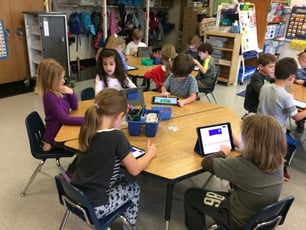Sarah Schemanske is a PLTW Launch Lead Teacher at Wines Elementary in Ann Arbor, Michigan. Sarah teaches PLTW to all students in kindergarten through fifth grade. Sarah has previously taught robotics and created and led a district-wide robotics challenge and an after-school robotics club for 11 years.
Ann Arbor Public Schools, in conjunction with a grant and private donors, has launched PLTW in every elementary school district-wide – 22 elementary schools total. What a huge initiative that speaks volumes to community members about how confident the district is in the positive effects of the program!
Below, I've outlined eight lessons I've learned during my PLTW journey:
- The most successful aspect of our program has been sharing our successes! Students love celebrating their accomplishments, no matter how small.
The most effective method of sharing has been having students post videos in Canvas. When students work in groups, the group can upload one video, and it automatically uploads to all group member accounts. Posting videos is great because students can log in from any computer and share with parents, friends, and grandparents. This approach allows the excitement from the classroom lessons to carry over into home. Students get to show off what they have learned and parents are beyond impressed with what students are accomplishing.
In addition, we send a weekly newsletter electronically and post content to Twitter.
The more "publicity," the better! Parents love seeing their children involved in hands-on, engaging, project-based learning. Best of all, PLTW is becoming a household name and frequent topic of discussion.
- The students frequently find success by learning from their peers. They LOVE being resident experts and advising groups that are stuck or confused on a step their group has progressed beyond. This not only boosts the group member’s self-esteem but also allows multiple resources within the room rather than groups sitting stagnant as they await the teacher's help.
- It is extremely helpful to stop and address the whole group once a question has been asked more than twice. In truth, multiple groups are asking because the steps were confusing or my directions were unclear. MANY groups are all curious about the same idea, whether they are willing to admit they are confused or not. Further explanation or clarification prevents frustration and helps the students continue to give their best and make the most of their PLTW time.
- We frequently discuss that it's OK to make mistakes. In these conversations, we also talk about how important it is to persevere.
- The students are continually teaching me. They help me learn new tools, shortcuts, alternative approaches, and more effective ways to program the robot.
- Students are REALLY engaged in the PLTW classroom. "Can we do PLTW during recess? PLEASE!!" This was an actual quote from an entire classroom at the conclusion of our PLTW lesson. What a testament to the program!
- Students tend to learn really well when instruction is modeled for them. Using reflector to project the teacher iPad on the board has been extremely helpful. After I demonstrate, then they get their iPads and mimic the motions. Once students have a foundational understanding, they are allowed to explore within their groups.
- I am amazed daily at how quickly the students learn and how their knowledge goes far beyond my expectations.
PLTW’s blog is intended to serve as a forum for ideas and perspectives from across our network. The opinions expressed are those of each guest author.


